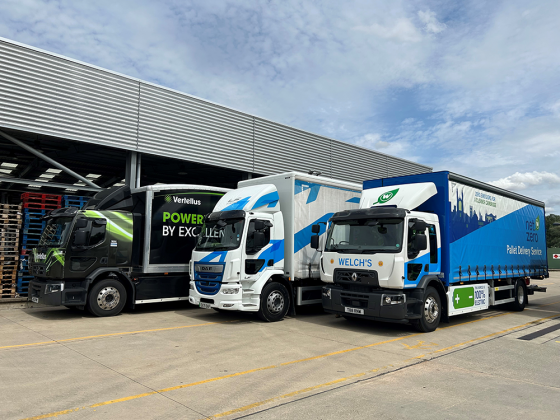Where do we go from here?
Geographic information can help enable better decision-making for drivers and those managing fleets, says Nigel Robbins, Chairman of AGI’s Transport Special Interest Group
 The recent growth in the use of map-based applications has been a major emerging technology in the transport sector over the last decade. This article discusses some of the recent trends, the benefits of using geographic information, as well as the key areas of application usage within fleet management.
The recent growth in the use of map-based applications has been a major emerging technology in the transport sector over the last decade. This article discusses some of the recent trends, the benefits of using geographic information, as well as the key areas of application usage within fleet management.
Transport and geography are inseparably linked. Indeed, it is often stated that 85 per cent of all business information has a geographic context. Within transport, geographic information is normally associated with the presentation of supply (such as transport networks and their assets) and demand (such as customer locations or addresses). By integrating electronic mapping ranging from portal or in-built satellite navigation system through to Intelligent Transport Systems, including traffic control monitoring centres, geography can help underpin better-decisions. With increasing pressure on costs and the desire to minimise the impact of travel on the environment, geography will play an increasingly important information dimension. Understanding the importance and role of geographic information within this process can help bring better decision-making and efficiencies in the planning and operations of transport.
Smarter planning
The management of transport-related information is vital to the effective planning and on-going operation of transport. A Geographic Information System (GIS) can support this function, utilising tools and procedures that have been developed to help organisations manage geographic data. A GIS enables the integration of the digital maps and location-based data (such as customer addresses or vehicle tracking locations) and to analyse this information against a map backdrop. Typically the GIS will require base digital maps at various scales, GIS software, or digital mapping embedded into an application, as well as linkage to information contained within your organisation. A GIS can therefore help your business drive down transport costs, improve customer service and provide smarter access to information. It should emphasised that GIS is an embracing term.
Whenever we log onto the internet to find a location of interest (say a hotel) we expect to find a map on the website that provides directions. The likes of Google Maps and Bing Maps have done much to promote the use of geographic information as a ubiquitous information resource often delivered in an easy to use way. Examples might include applications to track vehicles and determine the optimum allocation of an organisation’s resources to the customer demands.
GIS through the ages
However, the use of geographic data to better inform fleet decisions is not a new concept. In the 1980s and early 1990s, considerable growth was seen in the use of geographic routeing and scheduling tools to support the fleet industry where the technology proved it could provide a significant return on investment (ROI). Early implementations (often standalone PC desktop-based solutions) reported promising use and often large cost savings. During the 1990s these technologies have expanded and shown cost savings of typically 15 per cent as well as service improvements by improving reliability of delivery within increasingly constrained time-slots. However, these technologies where typically office-based solutions. The key outputs were often only printed routes of a specific journey or a customer call schedule. The technologies where relatively limited compared to current offerings.
The impact and opportunities presented through the rapid emergence of mapping solutions to support more effective travel should not be underestimated. The use of web and mobile-based navigation solutions have become widespread and indeed often an integral method for managing and improving travel. At the same time, the advent of smart mobile phones now means that staying in-touch with the office and the receipt of real-time information is now much more achievable even compared to only a few years previous. This leads to greater communication and timely action to redirect customer service requirements. This also promotes the opportunity to use geography to help inform decision-making, drive down variable and fixed costs.
Improving fleet operations
Several key areas for the application of GIS-type solutions within the transport and fleet management sector now exist.
At the most basic level, fleet managers may provide personal in-car navigation solutions utilising entry-level digital mapping. These solutions provide varying levels of route choice and selection tools, typically based on 2D or 3D mapping. Still popular is the use of these in-car solutions as a standalone handheld unit. This is now moving towards smart phone technologies with in-built vehicle navigation software, negating the need for a separate navigational unit. It also opens up the opportunity to use the smart phone as an office interface to centralised call and customer management solutions and strengthen office and field-based work processes. It is interesting to observe that the key road network datasets providers in the market place – TeleAtlas and Navteq – have recently been acquired by mobile phone operators. Such entry systems could be off-the-shelf solutions to help reduce mileage and estimate travel times.
At the most sophisticated level, fleet managers have a wealth of solutions now available to them that use intelligent integrated solutions to provide whole work-flow solutions. Many of these technologies provide integration between the driver and the office. As many systems provide a view on where the drivers are located through GPS linkage and the customer locations (derived from Customer Management Systems), these system lead to improved service through more timely redistribution and optimisation of customer calls. The predefined routes and the monitoring of the routes by despatch controls means that productivity can increase at the same time as costs are reduced.
To back this up, Opti-time, a provider of a range fleet management solutions, has quoted Peterborough City Council Social Housing Services – which manages over 10,000 homes – as saving more than two million Euros through implementing their fleet solution.
Managing the roads
The above are perhaps some of the more obvious examples where geography and transport through the adoption of GIS and telematic-based solutions are supporting fleets. These solutions tend to be at the microeconomic or business level. However, fleets are also being impacted by GIS technology at the macro-economic level. GIS is now being used by government to help in the efficient management of the highway and road networks.
GIS technologies transcend government by supporting a range of decision-making processes. At the strategic level, geographic information can be used to support and inform a range of strategic options. During the planning process for new roads, GIS technologies are being used to assess network changes, and to quantify the potential impact associated with network and route improvements. Likewise, the power of GIS to collate and analyse demand data (such as traffic movement data) and readily visualise changes arising from network amendments is significantly helping highway and public transport planners better understand the resulting potential network performance.
At the operational level, GIS solutions are highly beneficial in supporting the management of transport networks – they help to answer a number of the ‘where’ questions. In England and Wales, for example, the new Traffic Management Act (TMA) legislation came into force in April 2008. The TMA is specifically designed to help reduce disruption to the road network by consolidating maintenance effort associated with street assets. To ensure coordination of works on the highway network, the local authority and statutory undertakers (water, gas, electricity and telecoms companies etc) are required to share with each other the geographic location on where they propose to carry out works. This aims to provide improved coordination of asset management activities on the road network and reduce travel delays. The UK is now starting to see the development of solutions using embedded GIS technologies to show the location of these works and support the delivery of these coordinating solutions. The Highways Agency Traffic Map website provides such an example of an application where a GIS is used to show traffic delays on the network managed by the Highways Agency.
All these solutions and the wider use of geographic information can only benefit fleet operations.
Creating efficient operations
Whether it is in the strategic planning or operational management of transport operations and networks, geographic information and its associated technologies will become increasingly important to helping to create and sustain efficient operations. By putting the ‘where’ into transport decisions, geographic information within the transport arena has a vibrant future. Fleet managers need to remain aware of their technical options and understand fully the likely impact on their business as well as the opportunities for improvement.
Nigel Robbins is managing director of GeoSolveIT and Chairman of the AGI’s Transport Special Interest Group.
About the AGI
The AGI exists to represent the interests of the UK’s geographic information (GI) industry; a wide-ranging group of public and private sector organisations, suppliers of GI software, hardware, data and services, consultants, academics and interested individuals.
The AGI have recently established a Transport Special Interest Group. The AGI has an important role to play in helping organisations understand the value of geography within the transport arena, to raise awareness with key decision-makers, particularly in government, as well as promoting best practice.
For more information
Information about the AGI Transport Special Interest Group can be found on the AGI website www.agi.org.uk






